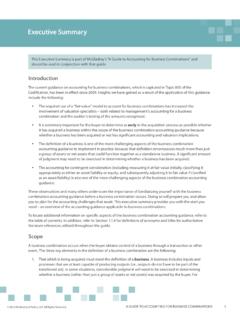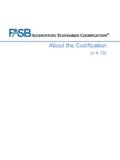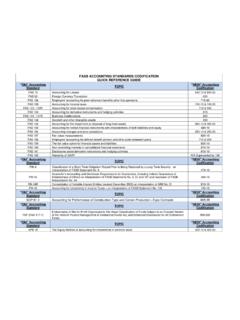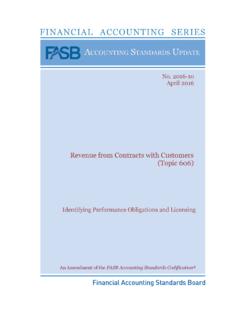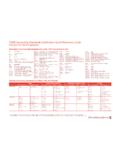Transcription of U.S. GAAP vs. IFRS: Fair value measurements at-a-glance
1 GAAP vs. IFRS: Fair value measurements Prepared by: Richard Stuart, Partner, National Professional standards Group, RSM US LLP +1 203 905 5027 July 2020 Introduction Currently, more than 120 countries require or permit the use of International Financial Reporting standards (IFRS), with a significant number of countries requiring IFRS (or some form of IFRS) by public entities (as defined by those specific countries). Of those countries that do not require use of IFRS by public entities, perhaps the most significant is the The Securities and Exchange Commission (SEC) requires domestic registrants to apply generally accepted accounting principles (GAAP), while foreign private issuers are allowed to use IFRS as issued by the International accounting standards Board (which is the IFRS focused on in this comparison).
2 While the SEC continues to discuss the possibility of allowing domestic registrants to provide supplemental financial information based on IFRS (with a reconciliation to GAAP), there does not appear to be a specified timeline for moving forward with that possibility. Although the SEC currently has no plans to permit the use of IFRS by domestic registrants, IFRS remains relevant to these entities, as well as private companies in the , given the continued expansion of IFRS use across the globe. For example, many companies are part of multinational entities for which financial statements are prepared in accordance with IFRS, or may wish to compare themselves to such entities.
3 Alternatively, a company s business goals might include international expansion through organic growth or acquisitions. For these and other reasons, it is critical to gain an understanding of the effects of IFRS on a company s financial statements. To start this process, we have prepared a series of comparisons dedicated to highlighting significant differences between GAAP and IFRS. This particular comparison focuses on the significant differences between GAAP and IFRS related to fair value measurements . The guidance related to fair value measurements in GAAP is included in the Financial accounting standards Board s accounting standards codification (ASC) Topic 820, Fair value Measurement.
4 In IFRS, the guidance related to fair value measurements is included in IFRS 13, Fair value Measurement. Comparison Under both IFRS and GAAP, fair value is defined the same: Fair value is the price that would be received to sell an asset or paid to transfer a liability in an orderly transaction between market participants at the measurement date. The significant differences between GAAP and IFRS with respect to how this definition is applied are summarized in the following table. 2 AUDIT | JULY 2020 GAAP IFRS Relevant guidance ASC 820 IFRS 13 Recognition of day-one gains and losses (which arise when the transaction price does not equal fair value ) The recognition of day-one gains and losses is required, even when the inputs to a fair value measurement are not observable, unless other guidance in the codification prohibits the recognition of such a gain or loss.
5 In certain situations, the recognition of day-one gains and losses is prohibited when the inputs to a fair value measurement are not observable. For example, in some cases, the difference between the fair value and transaction price of a financial instrument at the acquisition date is deferred (instead of recognized as a day-one gain or loss) when the inputs used to measure the fair value of the financial instrument are not observable. The deferred difference is subsequently recognized as a gain or loss only to the extent that it arises from a change in a factor (including time) that market participants would take into account when pricing the asset or liability.
6 accounting for certain investments A practical expedient permits estimating the fair value of certain investments using net asset value (NAV) when both of the following are true: The investment does not have a readily determinable fair value . The investment is in an investment company, or is an investment in a real estate fund for which it is industry practice to measure assets at fair value on a recurring basis and to issue financial statements that are consistent with the measurement principles applied to investment companies. A practical expedient for estimating the fair value of certain investments using NAV does not exist.
7 3 AUDIT | JULY 2020 GAAP IFRS Disclosures A quantitative sensitivity analysis is not required. A quantitative sensitivity analysis is required for financial instruments measured at fair value and categorized in Level 3 of the fair value hierarchy if changes to those inputs could result in a significantly higher or lower fair value measurement. These are the significant differences between GAAP and IFRS related to fair value measurements . Refer to ASC 820 and IFRS 13 for all of the specific requirements applicable to fair value measurements . In addition, refer to our GAAP vs. IFRS comparisons series for more comparisons highlighting other significant differences between GAAP and IFRS.
8 Consult your RSM US LLP service provider concerning your situation and any specific questions you may have. You may also contact us toll-free at for a contact person in your area. +1 800 274 GAAP vs. IFRS: Fair value measurements resulted from the efforts and ideas of various RSM US LLP professionals, including members of the National Professional standards Group, as well as contributions from RSM UK and RSM Canada professionals. This document contains general information, may be based on authorities that are subject to change, and is not a substitute for professional advice or services. This document does not constitute audit, tax, consulting, business, financial, investment, legal or other professional advice, and you should consult a qualified professional advisor before taking any action based on the information herein.
9 RSM US LLP, its affiliates and related entities are not responsible for any loss resulting from or relating to reliance on this document by any person. Internal Revenue Service rules require us to inform you that this communication may be deemed a solicitation to provide tax services. This communication is being sent to individuals who have subscribed to receive it or who we believe would have an interest in the topics discussed. RSM US LLP is a limited liability partnership and the member firm of RSM International, a global network of independent audit, tax and consulting firms. The member firms of RSM International collaborate to provide services to global clients, but are separate and distinct legal entities that cannot obligate each other.
10 Each member firm is responsible only for its own acts and omissions, and not those of any other party. Visit for more information regarding RSM US LLP and RSM International. RSM, the RSM logo and the power of being understood are registered trademarks of RSM International Association. 2020 RSM US LLP. All Rights Reserved.




